Berkeley Haas Case Series
The Berkeley Haas Case Series is a collection of business case studies created by UC Berkeley faculty
The Berkeley-Haas School of Business: Codifying, Embedding, and Sustaining Culture (A) case ended with a central question: What should the dean and school do to keep the culture strong and valuable through a transition to a new dean? This B case provides an overview of actions that Berkeley’s Haas School took over the 2017-18 academic year to address that question.
The Haas School’s vision included being the “most distinguished-by-culture business school.” This element of the vision took shape through codifying four Defining Principles in 2010, which in 2017 came to be called the Defining Leadership Principles, or DLPs—a change in nomenclature that connected them more to the school’s mission of developing leaders uniquely characterized by embodying the principles. The school’s four DLPs are:
Prior to 2010, the school’s culture had been latent, though present in the school for generations. Ever since Dean Rich Lyons made the decision to intentionally prioritize the DLPs, they had become a strong differentiator among students, prospective students, alumni, companies, and recruiters. For example, surveys of all three of Berkeley Haas’s MBA programs1 and the undergraduate program found that 75 percent of students cited the principles as a strong reason for choosing Berkeley Haas. More than 90 percent of alumni from the past decade were familiar with them, and more than 90 percent cited them as beacons in navigating their careers and lives. Exhibit 1 is an example of the impact on admitted-student decision making, showing that culture and DLPs had become the single most important factor motivating full-time MBA admits to choose Haas.
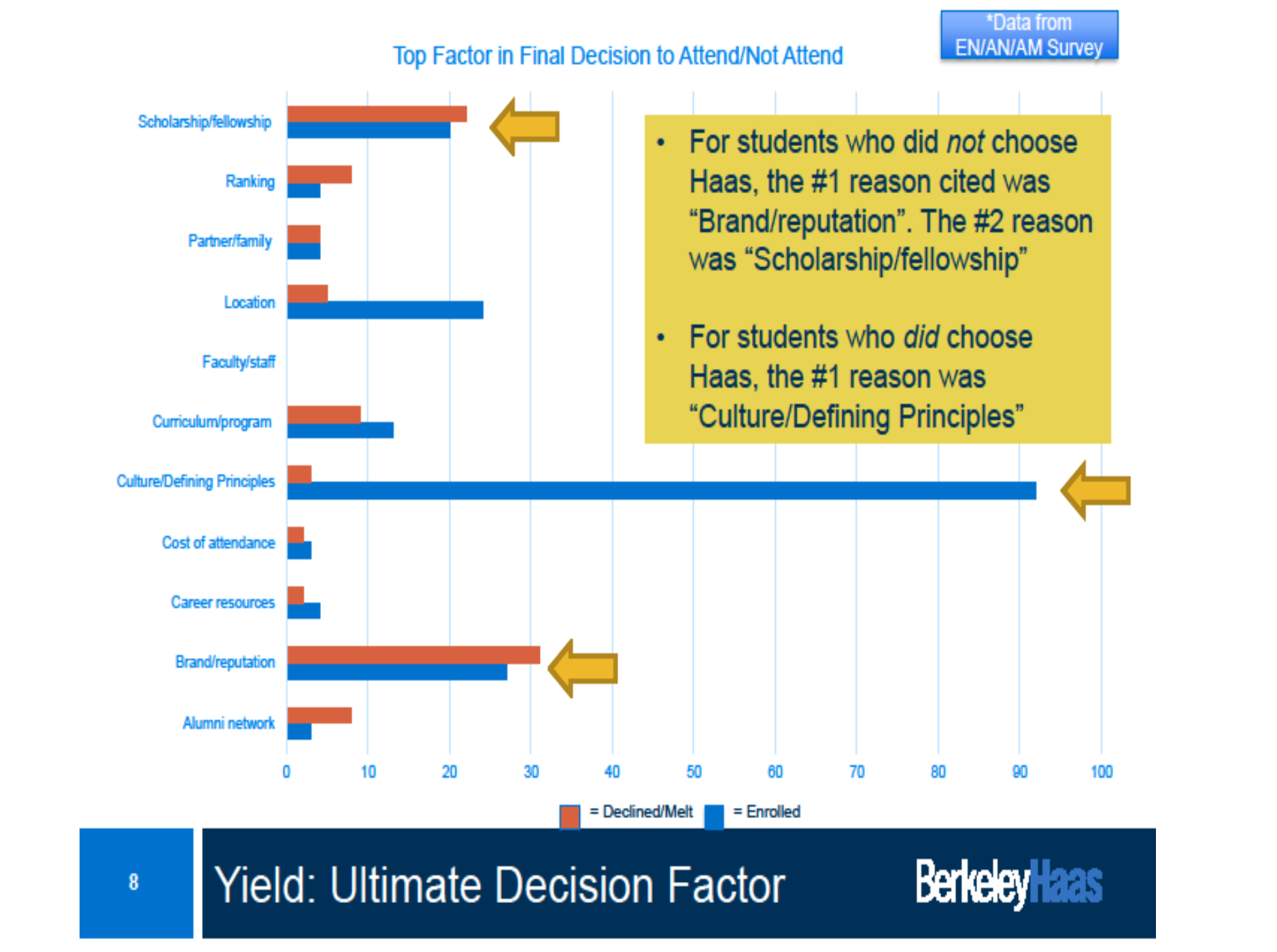
“Culture/Defining Principles” Becomes the #1 Decision Factor
Data from 2017 survey of all people admitted to the Haas School’s full-time MBA program. As is typical of top schools, those admitted are generally admitted to 2-4 other strong schools. Even among those who do not ultimately choose Haas, response rates for this survey are roughly 90 percent, so the data are robust.
Tangible results from the culture strategy in admissions and other areas (e.g., Executive Education client wins, culture-motivated philanthropy, media attention) came from executing on the culture strategy over the 2010-17 period, which was extensive and is described in part (A) of this case. Still, the dean-transition year, 2017-18, presented specific challenges and opportunities.
Based on ideas generated from discussions of part (A) of the case, as well as direct contributions from students, alumni, faculty, and staff across the school, a host of “transition-focused” culture initiatives were identified and implemented. These efforts were aimed at even more deeply embedding the DLPs into the Haas culture. Ten of the most substantial of those initiatives are identified here.
In May of 2018, the DLPs were carved onto the building in five-inch letters at the front entrance of the school (Exhibit 2), with obvious symbolic importance and permanence. The practical importance included their visibility to the thousands of first-time visitors to the Berkeley campus who start their campus tour across the street from the Haas School, at Memorial Stadium. The Haas academic building is the first building on campus to which visitors are introduced, now with the words etched into stone and sharply evident from that introduction point. The idea to carve the DLPs into stone was first raised at a meeting of the Culture Champions/Deputies (see Initiative 6 below).
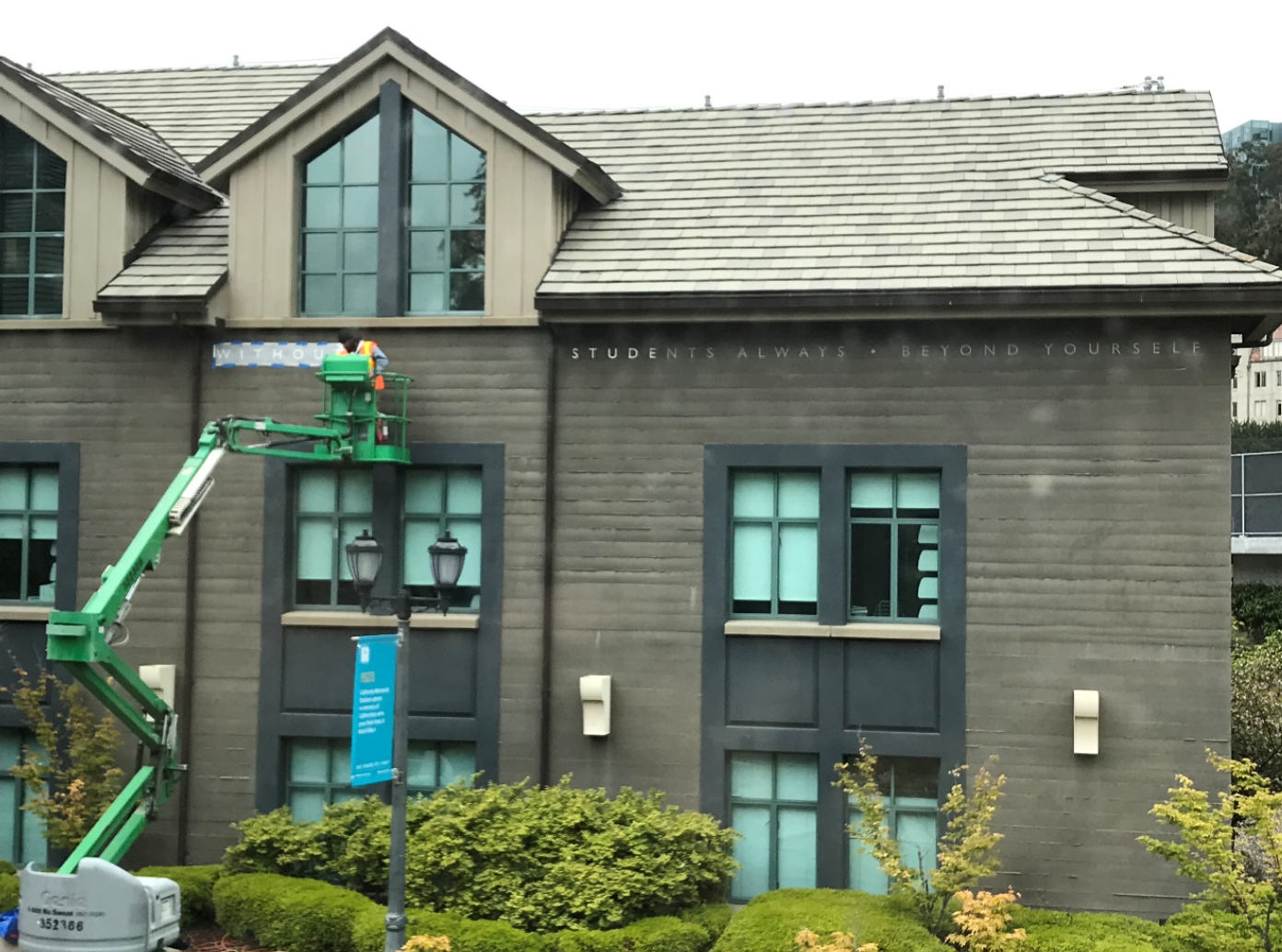
Carving the DLPs “in Stone” along the School-Front Roofline
Work was completed in May 2018. Final engraved lettering was highlighted by gold-leaf paint.
The students led in creating and administering the first “pulse survey” that allowed the school to track consistent feedback over time across all programs and constituencies, develop a baseline in which to measure the culture and provide a resource for stakeholders to evaluate themselves and each other (e.g., 360 view). Feedback prior to 2017 was more haphazard, focusing mostly on alumni awareness and DLP traction in admissions.
The Board of the School signed and sent a memo, prior to the identification of finalist candidates for the dean search, to the entire Berkeley Haas community (students, alumni, staff, faculty, and campus administration) stating unequivocal support for the four principles as well as their commitment to do a Board review one year into the next dean’s term to see how the community did in keeping the culture asset strong. The memo itself is presented in Exhibit 3. The Board was eager to sign and send this letter, indicating their substantial and sustained support for the DLPs. It is unclear if this explicit show of support by the Advisory Board would have surfaced if not for the special nature of the dean transition as well as numerous discussions about codifying and strengthening the culture over the years.
Board Email sent 3/16/18 to all Faculty, Staff, and Students
Dear Haas School Community:
In advance of identifying the next Dean of the Haas School, we as Haas Board members wanted to express our strong support for our school's four defining leadership principles: Question the status quo, Confidence without attitude, Students always, and Beyond yourself. In our judgment, these principles and the culture they shape are important to the Haas School's future and a source of competitive advantage for the school.
In making this statement we do not intend to suggest that the Haas School's culture should not evolve over the next decade. It can and must. Our point is rather that there remains much opportunity to strengthen and evolve the culture without needing to change the four principles themselves (e.g., evolving how the principles connect our students to companies, or how the principles play out in terms of specific behaviors).
To do our part, we also want the community to know that we plan in the Summer of 2019 to do a "Culture Review." We want to make sure that we as a community are following through on a level of ownership of the culture and principles that they deserve.
As has been noted, a vision statement with respect to culture that has been animating us for a long time is that "Haas will be the most distinguished-by-culture business school." Let's work together to continue to advance that future.
Regards,
The Haas Board
Over the academic year the Assistant Dean for Instruction, Jay Stowsky, led a full inventory of the school’s curriculum to map all the places where DLP-related content is delivered. Three documents were produced: 1) A “coding map” that clarifies how, when reading a syllabus, to code whether and in what ways the DLPs were represented in that class; 2) A “takeaways” document with notes regarding each syllabus and a summary table at the end, which includes ways that existing courses can be tweaked to support even better the DLPs and targeted leadership behaviors; 3) A document focusing on what we called “exemplar classes” that were particularly effective at delivering on the targeted leadership behaviors.
Starting with the spring 2018 semester, the school introduced a new question on the teaching evaluation for all Haas classes and instructors: “This instructor represents well our school’s four defining principles.” (scale 1-7). This question replaced a question on the prior evaluation form that had been producing results that mirrored closely those of another question. Results from this question distinguished sharply the faculty who fully embodied the principles, and especially so in courses where the professor included the principles in course discussions.
Dean Lyons enlisted twelve culture “deputies” to always be on the lookout for opportunities to strengthen culture and culture communication. Deputies were faculty and staff who showed a passion for the DLPs and who agreed to be informal culture boosters. This was not a formal role, but rather, deputies made a commitment to informally look for opportunities to highlight and use the DLPs in new ways and to encourage others around them to further embrace the DLPs. The deputies—who now use the term Culture Champions—were named early in the year, some through self-identification, some through nominations by others, some through demonstrated deep commitment to the DLPs over the years. Those agreeing to be deputized were all clear that they were not part of a committee, but instead are individually responsible to lead informally. As a small example, each developed their own New Year’s resolutions for how they will advance the culture over the following year. The Culture Champions met regularly during 2018 to review strategies and joint collaborative efforts.
The school launched a brand effort to integrate the four principles even more fully into the school’s identity, both internally and externally (and to help people understand the distinction between culture, which focuses more on shared behavioral norms, and brand, which focuses more on the school’s identity externally). One manifestation of this is the shift in nomenclature from defining principles to defining leadership principles. Haas, like many business schools, refers to developing leaders in its mission statement. That the DLPs are directly contributing to the mission was an important integration. Data from the pulse survey helps the school to identify which constituencies of the culture need additional attention to fulfill the truly enterprise-wide aspiration. Thus, the school sought to improve its understanding of how the DLPs were understood externally, particularly as it affected the brand promise of the school. The school also more deliberately articulated, particularly externally, how the culture differentiated the school. Exhibit 4 presents the model behind how the school thought about the role of culture differentiation.
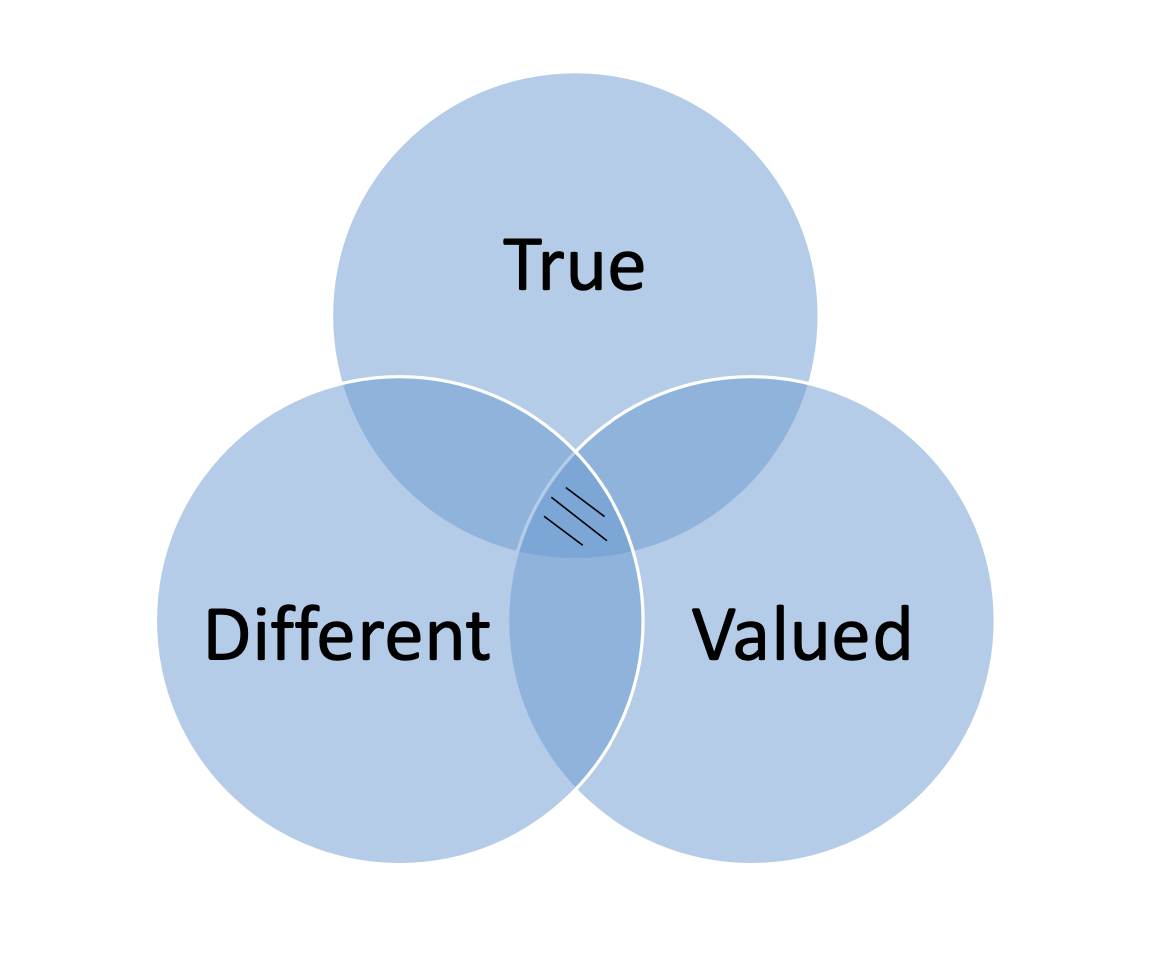
Culture Diagram – Unique Selling Proposition
Unique selling propositions (USPs) satisfy three criteria: They communicate an offering that is True, Valued, and Different. For culture, being True is most fundamentally about execution— driving cultural norms and values through all business processes, actions and communications. Being Valued at a high level requires identifying behavioral norms that are as relevant as possible to the success of the enterprise. Being Different is, among the three, perhaps the most difficult to achieve: enterprises too often choose values/principles that in themselves have little or no differentiating value.
The (A) case was published and also used in many ways to continue to build the culture including: teaching it in Haas classes, supporting it being taught at other schools, and providing it to recruiters. Another way that the case was valuable was in providing a vehicle for telling the foundational origin story of the four DLPs. This was essential because, by 2017, a large fraction of Haas staff, for example, were not working at the business school in 2010 when the effort was formally launched, and therefore had no sense for the context and rationale. An excerpt from part (A) on how the school converged on those four principles is in Exhibit 5.
Codifying Culture in Four Defining Principles
From the earliest stages of the culture strategy in 2008-09, dean Lyons and his team felt that the culture needed to stem from essential elements of the existing culture, rather than to create some ideal that would likely feel inauthentic to people. He added: “The notion of codifying what is already here is part of finding, rather than creating, our voice—moving from an implicit culture to an explicit one.”
During this process of evaluating what they had, the team determined that their culture stemmed from three things: “Place, People, and Culture.” Place meant being a part of the greater university, regularly among the world’s top five universities and located in the San Francisco Bay Area where innovation and entrepreneurship flourished. People meant that Berkeley-Haas had always been a good fit for leaders who put fresh ideas to work in their organizations. Culture meant that Berkeley-Haas had a differentiating culture where its students tended to question the status quo, possess confidence without attitude, and commit themselves to larger causes. Once the team identified aspects of its unique culture, they leveraged some of those elements to articulate what they then called the Defining Principles.
Lyons explained: “Our four principles have always been the Berkeley-Haas heartbeat, but we had never articulated them before, and had never used them to deliberately shape our students and graduates.” The preamble of the Defining Principles stated: “We have long lived by principles that define and differentiate us. These include excellence and inclusion, centerpieces for all of U.C. Berkeley. As part of a world-renowned university, we are inspired and expect to achieve excellence in all that we do. Differences in thought, too, are a Berkeley hallmark—our broad mix of cultures, backgrounds, and perspectives has always led to more creative outcomes. For the Haas School, there are four principles that, taken together, sharply define us relative to our peers.” That preamble was important: It made room for leaving over-used words like excellence – which have no power in themselves to differentiate – off the “defining” list.
This important process was revamped to include the culture case, The Berkeley Haas School of Business: Codifying, Embedding, and Sustaining Culture (A), which documents the culture’s origin story and other culture-related information such as the culture’s impact on improving admissions yield, and the role culture played in teaching evaluations. In a typical year the school hires approximately four tenure-track/tenured faculty and about seven professional faculty (Adjunct Professors and Lecturers). Most professional faculty, due to their professional background, have direct experience with organizations that are intentional about culture, either their own as entrepreneurs or in various companies as leaders. Tenure-track faculty—especially those who join Haas right after graduating from their Ph.D. program—typically have never been part of an organization that is intentional about culture, so this material is particularly eye- opening for them.
Culturally relevant fundraising was also prioritized during the transition-year culture effort. The school launched a Culture Leadership Fund that it pitched to many of its closest donors and friends. Not only did the fund spark many conversations with important constituents, it also surpassed its target, raising just over $230,000 to be used for additional, culture-strengthening initiatives over subsequent years.
These ten initiatives, while considered key, constituted only a partial list of the changes made over the 2017-18 year. Coupled with the selection of a new dean who conveyed commitment to the culture and knows Berkeley well (Ann Harrison got her undergraduate degree from Berkeley and was on the faculty of the College of Natural Resources for a decade), these developments were intended to secure the culture’s future at Berkeley Haas.
Execution on these ideas during the transition year was viewed as fundamentally important to the continuity of the Berkeley Haas culture. The progress that was made during this critical year benefitted from a process devised early, largely through the work of the Culture Champions (noted in initiative 6) above. One of the early ideas was to direct an MBA team in the school’s experiential-learning program to focus on the school itself to address—with the guidance of the McKinsey consultant who worked with the team—what Haas could do over the year to support its culture. The pulse survey noted above emerged directly from that work, as did emphasis on driving culture deeper into teaching evaluations and into how the school articulated its brand.
The Haas Board was also deeply involved in identifying and supporting the ten key initiatives. The Board memo (noted in initiative 3) was just part of it. The Board also did a project over the summer of 2018 on the Haas brand and how the DLPs could connect to it most effectively. The Chair of the Haas Board, Jack Russi of Deloitte, was also quite supportive of several changes that, without the Board’s support, might have been difficult to execute (e.g., driving the DLPs into the stone along the roofline of the front of the building). The Board’s active approach was stimulated in part by an invitation from Dean Lyons in spring 2018 to Professor Chatman, as a culture expert, to lead the Board at one of their meetings through a structured exercise to consider how they could help in the transition to embed the DLPs more completely.
Students were heavily involved over that year as well. Beyond the experiential-learning team, the students contributed ideas that came out of class discussions of part A of this case. For example, they offered ideas on how to connect the promise of the DLPs more deeply into the school’s partnership with recruiters by being explicit about what leadership behaviors the school excel at and how recruiters can probe for them in interviews.
Communications is another distinct dimension of the process the school invested in heavily over the year. For example, the school took care to include explicit reference to the DLPs and their importance in the job description released to the public to launch the dean search process. The school also dedicated one of the year’s three issues of the alumni magazine, BerkeleyHaas, to the school’s culture. Former Dean Lyons made repeated reference to the importance of the DLPs in sharply defining the school relative to competitors in his dean’s columns in the alumni magazine. The vision statement of “making the school the most defined-by-culture business school” appeared repeatedly across an array of internal media.
Jennifer A. Chatman, Paul Cortese Distinguished Professor of Management and Richard K. Lyons, former Berkeley Haas Dean and William and Janet Cronk Professor, prepared this case as the basis for class discussion rather than to illustrate either effective or ineffective handling of an administrative situation. The preceding A case is available at: cases.haas.berkeley.edu/cases/berkeley-haas-culture/.
Copyright © 2019 by The Regents of the University of California. Permission to freely distribute this (A) and (B) case granted. For more information, please contact cases@haas.berkeley.edu.
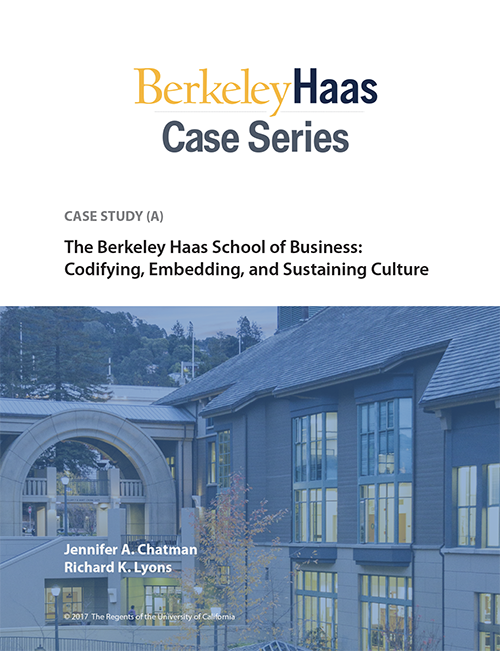
In June 2017, as 56-year-old Richard Lyons, dean of the Berkeley-Haas School of Business prepared to make his announcement to step down (at the end of June 2018), he looked at his guitar in the corner of his office. He reflected on all the times he had played it for his students and the Berkeley-Haas community and beyond. A flood of good memories streamed through his mind because he had served in various roles at the school for 24 years, most recently as dean for the past 11 years. Still, a major question weighed on him: Would the culture and defining principles codified during his deanship outlive his term as dean?
Learn more
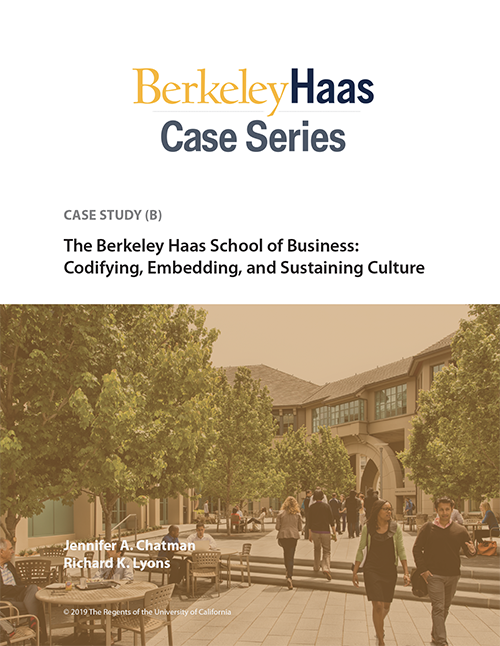
The Haas School’s vision included being the “most distinguished-by-culture business school.” Part (A) ended with a central question: What should the dean and school do to keep the culture strong and valuable through a transition to a new dean? This B case provides an overview of actions that Berkeley’s Haas School took over the 2017-18 academic year to address that question.
Learn more

The Berkeley Haas Case Series is a collection of business case studies written by Haas faculty. Our culture and vision at the Haas School of Business naturally offer distinctive qualities to the Series, filling a gap in existing case offerings by drawing upon lessons from UC Berkeley's rich history and prime location in the San Francisco Bay Area. We seek to publish cases that challenge conventional assumptions about business, science, culture, and politics.